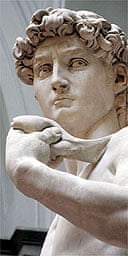Cinzia Parnigoni thanked everyone - from Tuscany's top arts official to the people who had mixed the paste with which she cleaned the world's most famous statue.
And then, as she began to talk about what it was like to carry out the most important, and controversial, art restoration in years, it became too much. Tears welling in her eyes, she took refuge behind a screen.
Twice during the presentation of Michelangelo's David, Ms Parnigoni was overcome by the emotions built up in tackling a supreme masterpiece that dozens of experts feared she might ruin forever. "Sometimes, it wasn't easy to find the inner strength," she said afterwards.
On occasions, she has been so daunted by the task that she would stop and go back home, or break for a few hours. "The doubts and second thoughts weren't so much to do with technique, as with having to measure up to Michelangelo."
As she spoke, a newly unblemished David reared up behind her, visibly challenging the faint hearts, critics and doubters. David's blackened hair has been cleansed. The stains on each of his hands have gone, as have the unsightly streaks on his left shin. And, as Dr Franca Falletti, director of the Accademia gallery, noted, in some places the original shine of the marble had even returned. She did not specify where, but behind her, a distinct gleam could be seen on parts once covered by that metal fig leaf.
The overall effect is of a glowing colossus restored to something close to its Renaissance splendour. Visitors to Florence should not expect a dramatic transformation, such as that wrought on Michelangelo's frescoes in the Sistine Chapel in Rome in the 1990s; but, because of the greater uniformity of colour, it is easier than before to appreciate the statue's exquisite detail - the vein that stands out ever so slightly on David's upper right arm, for example.
Ms Parnigoni began the job of restoring the 17ft, five-tonne statue last September after her predecessor had resigned - unwilling to press ahead with a clean-up she feared could do irreparable damage.
Agnese Parronchi had wanted to use brushes to sweep off the grime that had built up on a statue which, for more than 350 years, stood in the Piazza della Signoria before being replaced by a copy. After the original was taken into the Galleria dell'Accademia in 1873, it was given a dousing in acid that made it even more susceptible to dirt, dust and the breath of more than a million visitors a year.
Over the centuries, the world's most celebrated male beauty has been struck by lightning, had an arm broken off by rioters, had a toe smashed with a hammer, and suffered the indignity of a metal fig leaf being attached to his genitals.
After Ms Parronchi's departure, 39 experts, headed by James Beck, a professor at Columbia University, signed a petition pleading for time so that an international commission could decide which method would be least damaging. But that would have meant having David dirty for his birthday in September, the 500th anniversary of his unveiling.
Brushing aside doubts, Antonio Paolucci, Florence's arts overlord, authorised a more thorough clean-up, involving applying poultice-like packs for between 15 and 30 minutes.
"I mixed together cellulose, clay and distilled water to make a sort of cream ,and then wrapped it in Japanese rice paper before applying it. The paper let through the water, but stopped the paste coming into contact with the surface," said Ms Parnigoni. The hardest part was David's curly hair. "That was where it was most difficult to get the pack in."
The restoration began in September 2002 and cost a surprisingly modest €400,000, or £270,000. It was funded in equal parts by two charities, the Dutch foundation Ars Longa and Friends of Florence, whose members include the singer Sting and the actor Mel Gibson.
One effect of the clean-up was to show the cracks in David's left ankle discovered in the 19th century and caused by subsidence in the Piazza Della Signoria, possibly because of a flood in 1844. But, according to a statement, "in its present position [in the Accademia], the stresses to which the statue is subjected, remain within the limits of safety".
And the breath exhaled by visitors pouring through the Accademia was not having a dire effect, as some had feared. But dust brought in from the streets outside did represent a problem, and this is still being investigated. In any case, it has been agreed to monitor David continuously, with eight inspections and a dusting each year. One difficulty in restoration was the marble used by Michelangelo. "The quality of the marble is extremely poor," said Ms Parnigoni. As a result she was unable to use older treatments deployed in her earlier restoration of another Michelan gelo masterpiece, the Prisoners.
Prof Paolucci called the results of her work "a restoration that does not look like a restoration".
"Only someone with expert knowledge and a thorough and long familiarity with the 'skin' of the statue will be aware that certain aesthetically unattractive irregularities are no longer there ... that everything today looks more fluid, more consistent, more harmonious."
Dr Falleti said: "It is as if a thin grey veil had been lifted."
Speaking from New York, Prof Beck said: "I agree this restoration has been really moderate. This, however, is a victory for those of us who voiced concern."
